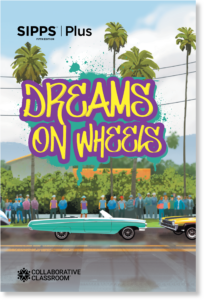How can we use age-appropriate, decodable texts to engage, motivate, and support older striving readers?
In this interview, veteran literacy educators Rod Hart and Cate Simmers explore this question and discuss Dreams on Wheels, the anthology of decodable, age-appropriate texts for older striving readers in SIPPS Plus.
Rod Hart is the SIPPS Program Manager at Collaborative Classroom. Cate Simmers is a consulting teacher and coach for Collaborative Classroom programs in Seattle Public Schools.

Introduction: A Passion for Serving Striving Adolescent Readers
Cate Simmers: Rod, would you tell us a little bit about your background as a reading teacher?
Rod Hart: I’ve had the gift of spending 30 years as an educator in public education. I’ve taught students from the earliest elementary grades to the university graduate level. But a passion of mine is literacy and reading education, especially working with striving adolescent readers.
Cate Simmers: You mentioned older striving readers, meaning our middle schoolers and high schoolers. Can you tell us more about your experiences with those students?
Rod Hart: I started my career in the 1990s when I was 21, teaching high school in the Bronx. I taught ninth graders as well as upperclassmen. My ninth-grade classes were always noticeably larger than my upper-grade classes.
After having taught there for a bit, I realized that not all of my ninth graders would make it to graduation. Most often, what’s lacking is the academic preparation for high school, especially regarding reading ability.
I made a shift in my career to teaching eighth grade ELA, with the mission that any student in my room would go to high school with the ability to read and do the academic work that high school demands.
Video: Rod Hart on shifting his career to focus on older striving readers
Motivating Older Striving Readers
Start with an Emotional Connection
Cate Simmers: How did you encourage these students to become motivated, stay motivated, and change their self-image as readers?
Rod Hart: We’re people, so it all starts with an emotional connection. I have a background in theater and experience building classroom communities where everyone learns together and feels connected. That includes teacher-student connections as well as comfortable peer communities.
The experience of older, striving readers is one in which they go through every elementary grade, end up in eighth grade, and they know they don’t read the same way that their peers do.
They go through years of school and struggle to read the books they’re given in any subject. They’re pulled out of electives and classes that they’d like to attend in order to receive remedial reading support.
And yet, even with all the years of instruction and interventions, the gaps in their reading skills are still there. Now, here they are in eighth grade. What’s going to be different?
Video: Understanding the experiences of older striving readers
Bringing Older Striving Readers into the Reading Community
It is so important to recognize what these bright, capable, beautiful young people are going through and find ways for them to be part of a reading community:
- Determine places for differentiation
- Identify opportunities that give them choice and voice
- Provide supports that will get them to grade-level text
Focus On Their Strengths
Often the conversations are about what the students can’t do, so I make sure to focus on their strengths.
Especially at the beginning of the year, I ask, “What are the skills that they have?” And then, “How can I connect reading to things that they already know, understand, and enjoy?”
I like to find and even set up opportunities for small wins, and then use those for leverage so they can reflect upon them. “Oh, look at how well you did that!”
Reflect on the growth to change the narrative in their head, the way they see themselves, and their identity. So it’s not all, “I can’t read,” but rather, “Oh, look how far I’m coming as a reader!”
Video: Empathizing with older readers and finding ways to focus on their strengths
Giving Older Striving Readers the Age-Appropriate Texts They Deserve
Cate Simmers: You mentioned differentiation. The texts these students have might look different than the grade-level texts of their peers. Yet we know that older striving readers deserve high-quality books about topics that interest them.
Tell us about your experiences finding and using texts that motivate these students.
Rod Hart: The key piece to becoming a confident, independent reader is to read. Many students who don’t read as well as their peers become very reading-resistant as they get older.
So, getting books or texts into their hands and providing opportunities for them to read is huge. And as you were saying, it’s not always going to be the same text that their classmates are reading.
The texts have to be accessible and relevant. For the teenage readers, it has to be about the things that they’re interested in. It has to have emotion and drama.
Maybe it has a little Gossip Girl feel to it, or it’s about a topic they love: music, sports, computer gaming, or whatever it is that allows them to engage more fully, develop those skills, and increase their academic performance.
It can be tough to find those Hi/Lo readers. The key is to make selections with a personal touch so that the books are not only accessible and relevant, but also the right book for the right reader at the right moment.
The “Book Talks” Strategy
Cate Simmers: In a previous discussion, you mentioned a strategy you use called book talks. Might you say a little bit more about book talks and how you use those to motivate students?
Rod Hart: I taught eighth-grade English classes with students reading at all different levels, including older striving readers.
Although I was not a reading interventionist, I liked to hide intervention strategies that looked as if they could be for anyone in the class.
One thing I used to do was carry a book with me everywhere I went in the building. I wanted to model that men read, and I encouraged my colleagues to do the same.
Often, the kids would ask me about what I was reading or what book I was carrying. And even if they didn’t ask, I would pull out the book and share a bit about it. Especially if it were a book like The Crossover, by Kwame Alexander, which is similar to a Hi/Lo book. It’s written in poetry rather than in paragraphs, making it more accessible for a lot of students. It’s also culturally responsive, having won the Coretta Scott King Award as well as being a Newbery Award winner.
So I would have a book and ask if anyone wanted to read it when I was finished. Often, I would try to make sure that the book got into the hands of the right student first.
Sometimes I would do it a little more personally. If I knew a student wasn’t going to raise their hand, I would ask, “Have you read anything by him?” or “Have you read this book?” and “Can I read you the beginning?” hoping that would inspire the student to take the book from me and read it.
Those “ninja” book talks always gave the appearance of being unprepared. And the kids loved them because it looked like they got me off track in the middle of class.
Video: Rod’s “book talks” strategies
What Are Hi/Lo Books, and How Do They Help Older Striving Readers?
Cate Simmers: You mentioned Hi/Lo books or texts. Might you explain those a little further?
Rod Hart: Collaborative Classroom has what we call Hi/Lo books. The way I like to think about them is that they’re books with high interest for my teenage readers but they’re written more on an elementary grade level, so the readability is low.

These books have relevant topics and are great at increasing engagement and motivation by aligning with the maturity level of our older students.
They’re terrific at building confidence, because our older striving readers need to feel confident and successful. They’ve had years feeling ashamed or feeling like failures.
So when they get books that they want and can and do read, it builds up their confidence and that feeling of success.
Video: The power of hi/lo books
Another thing that these Hi/Lo readers do so well is prevent frustration. They’re not overwhelming or particularly long.
Take, for example, The Crossover. It’s a thick book, but because it is written in free verse, it has far fewer words than a traditional novel that size. It’s a book many older readers are proud to carry in the hallway.
These books often explore complex themes, present intriguing ideas that require inference, and incorporate various text features. They invite critical thinking and students can relate to the struggles the characters face.
This allows them to engage in advanced comprehension activities with a text that is easier to decode, which helps develop higher-level reading skills.
How Dreams on Wheels Supports Older Readers in SIPPS Plus
Cate Simmers: In SIPPS Plus, we have a decodable Hi/Lo reader called Dreams on Wheels, with a newly revised and refreshed version in the fifth edition of SIPPS. Could you share what stands out to you about this new updated text?

Rod Hart: Dreams on Wheels is a great example of honoring older, striving readers. It’s a Hi/Lo, decodable reader.
The selections in Dreams on Wheels are aligned to the scope and sequence of SIPPS Plus, so the words in a given selection feature sounds, spelling patterns, or high-frequency words that the students have learned. It’s accountable. The students have the skills to decode all of the words in a selection, even if they’re still working on CVC words or words with long vowels with final E.
I am amazed at the high quality of Dreams on Wheels and the varied selections in it—there’s fiction, nonfiction, and even something similar to a graphic novel. Some texts have timelines and maps and captions and other features.
It’s a book that a middle schooler or a ninth or tenth grader wouldn’t be embarrassed about if it dropped, and somebody else picked it up and flipped through it in the stairwell. It looks like a book that somebody their age would be reading.
But each of the selections is decodable so the students can confidently read all of it. And then as the text goes on, each selection becomes a little more rigorous as it incorporates more of the spelling patterns and high frequency words that the students are learning in their SIPPS Plus instruction.
The new Fifth Edition version of the anthology has undergone an equity review that has resulted in greater and more authentic representation. So Dreams on Wheels contains high quality, relevant, accessible materials.
Video: Rod speaks about Dreams on Wheels, the Hi/Lo decodable anthology in SIPPS Plus
Cate Simmers: Something that’s new for the fifth edition of Dreams on Wheels is that in addition to just one selection per lesson there’s an additional set, correct?
Rod Hart: Yes. Often if the students are in SIPPS Plus, they’re still at a stage where they require a decodable reader. They’re not yet ready for those Hi/Lo texts.
So this new edition of Dreams on Wheels has a selection for each lesson, along with an additional 22 selections aligned to the scope and sequence of SIPPS Plus.
The kids have the opportunity to practice even more by applying their word recognition and decoding skills to accessible, relevant, mature-themed selections and passages.
The Importance of Sufficient Practice with Reading Decodable, Accessible Texts
Cate Simmers: Earlier, you mentioned the importance of giving students time to read independently and apply the skills that they’ve been learning so that they can do some self-teaching.
Practice seems to be a crucial component to becoming more accurate, more automatic, and consequently more fluent, wouldn’t you agree?.
Rod Hart: It’s true. You only become a great singer by singing, a great painter by painting, a great reader by reading. So having all of these decodable, accessible texts that they can read is key.
Cate Simmers: I’ve noticed that my students who have read Dreams on Wheels finally see themselves as readers.
They’re able to access that text and feel confident. They feel motivated to continue reading.
Rod Hart: I’ve noticed that as well, Cate. Most decodable readers are designed for kindergartners or first graders — and those are exactly the wrong thing to place in front of our striving older readers.
But there is such a difficulty in creating a decodable reader for older students.
Decodable readers should be aligned to the scope and sequence of the program they support. Students need to have been taught all of the spelling, sound correspondences, and high-frequency words that will appear in the decodable stories.
Dreams on Wheels is designed with this in mind.
Cate Simmers: Another thing that I appreciate about Dreams on Wheels is it gets students into actual reading from the first lesson, which is a feature you don’t see in a lot of reading intervention programs.
Rod Hart: Right. They need those small wins. They need that dopamine hit and that boost of confidence. You know, so I can tell them: “You came in here and told me you couldn’t read. Look at that. You just read that whole selection top to bottom.”
A strength-based approach builds confidence and inspires the desire to keep reading.
Cate Simmers: Thank you so much for sharing your experiences with older striving readers, your successes, and a little bit about the new edition of the Dreams on Wheels reader.
About the Authors

Cate Simmers is a consulting teacher and coach for Collaborative Classroom’s literacy suite in Seattle Public Schools and has over 20 years of elementary-age teaching experience.
She supported the implementation of Collaborative Classroom programs in her district and currently supports the SIPPS curriculum and teachers in its 75 elementary schools.
Rod Hart serves as the SIPPS Program Manager at Collaborative Classroom, managing all aspects of the SIPPS program, a structured literacy intervention focused on phonological awareness, phonics, and high-frequency words.
With 30 years of experience in public education, Dr. Hart has worked as a teacher, school-based leader, and district leader. In addition to his work in education, Dr. Hart is a public speaker, sharing his expertise and passion for literacy instruction.

Explore SIPPS for Older Readers
For students in grades 4–12 in need of early foundational skills, SIPPS offers a respectful and age-appropriate method for accelerating learning.

Related Reading
Helping Striving Readers in High School: Five Elements for Success
A Coach’s Perspective: How SIPPS Plus Supports Older Striving Readers
How Nystrom Elementary Implements the Walk to Read Model with SIPPS
Seven Questions to Help You Prepare for Successful Summer School Reading Intervention
